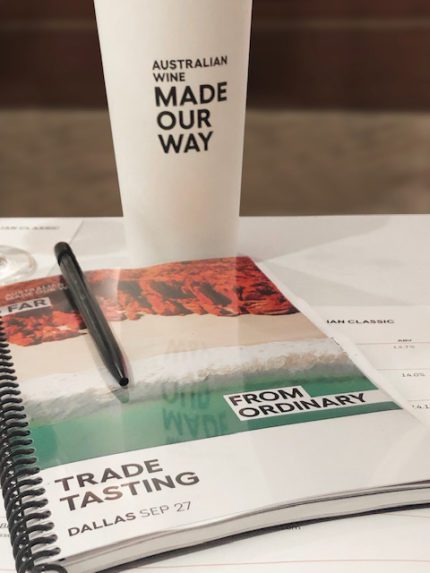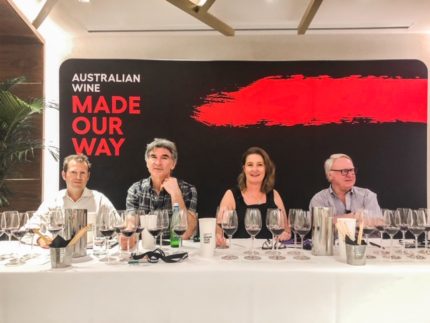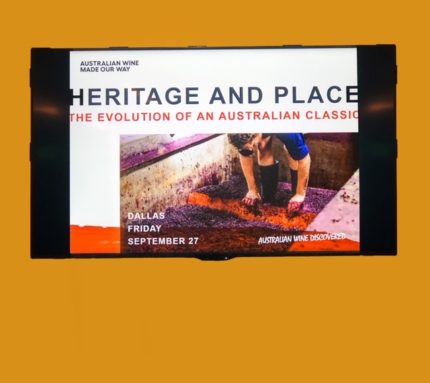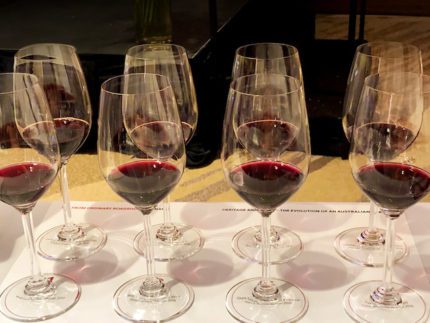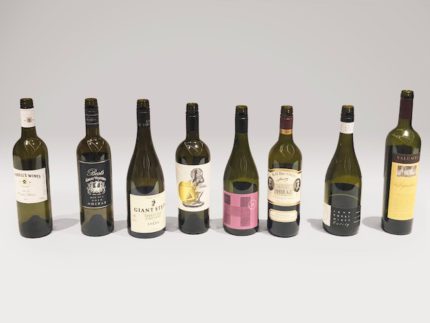It was billed it as a “Far From Ordinary Roadshow” and it was a grand effort by the Australian Government with a goal of raising the profile of Australian wine with a six-city U.S. roadshow featuring 100 wineries who spent more than two weeks talking about Australia’s dynamic winemaking scene. The roadshow was backed by a $50 million Export and Regional Wine Support Grant from the Australian Government.
Winemaker Tim Duval, John Duval Wines; Chief Winemaker Steve Flamsteed, Giant Steps; Chief Winemaker Kate Goodman, Penley Estate and Bruce Tyrrell, Managing Director of Tyrrell Wines
I attended the trade seminar led by Mark Davidson, Education Manager of North America at Wine Australia, that featured several of Australia’s first families of wine including Bruce Tyrrell, Managing Director, Tyrrell Wines; Steve Flamsteed, Chief Winemaker, Giant Steps; Kate Goodman, Chief Winemaker, Penley Estate and Tim Duval, Winemaker, Sales and Marketing for John Duval Wines.
In a press release, Wine Australia Chief Executive Officer Andreas Clark talked about the importance and growth opportunity in the U.S. market. “While Australian wine exports to the USA grew 2 percent to $432 million in the year ended June 2019, much work remains to increase our market share in the world’s biggest wine market,” he said.
A Brief History of Australian Winemaking
Australia’s winemaking history first began in 1788, when Governor Arthur Phillip brought the first vines to Sydney. In 1833, James Busby, considered the father of the Australian wine industry, brought cuttings from Spain and France and introduced Shiraz and Grenache.
Approximately 40% of vines grow in the state of South Australia, which is home to the Australian Wine Research Institute (AWRI). AWRI is responsible for much of the world’s research on dry farming techniques and commercial winemaking operations. In addition, 25% of the vines grow in the state of Victoria and the rest reside in New South Wales. There are 15 wine growing regions that produce more than 100 different grape varieties and 11 first families of wine that have been making wine for a combined 45 generations.
A Focus on Shiraz
We focused on Shiraz, but quickly learned the diverse styles that Australia is capable of producing by region. Mark talked about the different vines and the history they had. An Old Vine is considered 35+ years, a Survivor Wine is 70+ years, a Centenarian Vine is 100+ years and an Ancestor Vine is 125+ years.
Bruce talked about how the Shiraz grape grows in every region, climate and soil and is very different and Steve mentioned how it often treated more like a single clone.
We tried the following wines:
2017 Tyrrell’s ‘Vat 9’ Hunter Valley Shiraz
2016 Best’s Great Western ‘Bin 1’ Grampians Shiraz
2018 Giant Steps ‘Tarraford Vineyard’ Yarra Valley Syrah
2016 Penley Estate ‘Atlas’ Coonawarra Shiraz
2017 Henry’s Drive ‘H’ Adelaide Hills Padthaway Syrah
2015 Kay Brothers ‘Block 6’ McLaren Vale Shiraz
2017 John Duval ‘Entity’ Barossa Valley Shiraz
2014 Yalumba ‘The Signature’ Barossa Cabernet Sauvignon Shiraz
The regional differences were evident (please note these were impressions based on trying one glass of wine from each region during this seminar). Hunter Valley was a softer wine and had notes of floral, earth and lots of berry. Our Grampians offering was perfumed, spicy and intense. Yarra Valley, the coldest region, was elegant and earthy. Coonawarra was smoky with dark berry and eucalyptus notes. Adelaide Hills had notes of herbs, black pepper and dark berries. McLaren Vale was fuller-bodied and had more alcohol with notes of licorice, spice, tannins and flowers. The oldest vines come from the Barossa and I tasted plum, cherry, black fruit and lots of savoriness.
A Little About the Winemakers’ Wineries
Giant Steps
Founder Phil Sexton arrived in the Yarra Valley in 1997 looking for the right altitude, aged soils, slopes of exposure, regular rainfall and temperatures off the mountain ranges to make great Chardonnay and Pinot Noir.
Steve Flamsteed, the Chief Winemaker of Giant Steps, was obsessed with French wines and shared his vision. He joined in 2003 and built his winery “more like a kitchen than an individual winemaking facility. It’s all about creating a range of Single Vineyard wines that personify each site,” he said.
Australian winemaking
He also talked about the tie to jazz in naming the winery. When John Coltrane split with Miles Davis in the late 50s, he released his Giant Steps album. Phil was inspired by the album and when he sold his Devil’s Lair vineyard in Margaret River to relocate and replant in the Yarra Valley, he named his wine in Coltrane’s honor.
Giant Steps wines have been awarded 34 trophies and over 100 gold medals at major international and domestic wine shows and have been named one of the Top 100 Wineries in the World by Wine & Spirits Magazine, US, for each of the last six years
Australian winemaking
John Duval Wines
Five generations of the Duval family managed vineyards and operated a world-famous sheep farm in the Barossa Valley. The vineyards supplied Shiraz grapes and vine cuttings to Penfolds, and John Duval, Winemaker and Owner, served as Chief Winemaker for 23 years. After working at Penfolds for 30 years and 47 vintages, John knew it was time to start his own winery so he could be involved from the vineyard to the glass.
He started John Duval Wines in 2003 with a single wine, the inaugural vintage of PlexusShiraz Grenache Mourvédre and has grown to focus on small parcels of heritage varietals.
Penley Estate
Winemaking history dates back to 1844 with some pioneering South Australian women in the family –Mary Penfold, was the driving force behind the establishment of Magill Estate in 1844; Gladys Lethbridge, who married Frank Penfold Hyland in 1921, oversaw the running of Penfolds after his death and also served as Chairman of Board from 1948-61.
The two pioneering winemaking families came together in 1945 when Reginald Lester Tolley and Judith Anne Penfold Hyland met over a red sports car and Penley was the name chosen for the business when they married. However, the winery didn’t come to life until the children decided to create wines in 1988. They bought land in Coonawarra, planted grapes and called it Penley Estate and built a winery in 1995.
Tyrrell Wines
Tyrrell Wines was established in 1858 by English immigrant Edward Tyrrell in the Hunter Valley with additional vineyards in Victoria. Today, it is led by fourth generation family member Bruce Tyrrell and has been award over 5,000 trophies and medals and in 2010 was named “Winery of the Year” in James Halliday’s Australian Wine Companion.
After the tour, we had an opportunity to taste hundreds of wines from all varieties showing the diversity and excellence of what Australia has to offer.
Powered bywoohelpdesk.com

